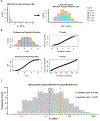A method for analyzing AFM force mapping data obtained from soft tissue cryosections
- PMID: 38648717
- PMCID: PMC11128031
- DOI: 10.1016/j.jbiomech.2024.112113
A method for analyzing AFM force mapping data obtained from soft tissue cryosections
Abstract
Atomic force microscopy (AFM) is a valuable tool for assessing mechanical properties of biological samples, but interpretations of measurements on whole tissues can be difficult due to the tissue's highly heterogeneous nature. To overcome such difficulties and obtain more robust estimates of tissue mechanical properties, we describe an AFM force mapping and data analysis pipeline to characterize the mechanical properties of cryosectioned soft tissues. We assessed this approach on mouse optic nerve head and rat trabecular meshwork, cornea, and sclera. Our data show that the use of repeated measurements, outlier exclusion, and log-normal data transformation increases confidence in AFM mechanical measurements, and we propose that this methodology can be broadly applied to measuring soft tissue properties from cryosections.
Copyright © 2024. Published by Elsevier Ltd.
Conflict of interest statement
Declaration of competing interest The authors declare that they have no known competing financial interests or personal relationships that could have appeared to influence the work reported in this paper.
Figures




Update of
-
A Method for Analyzing AFM Force Mapping Data Obtained from Soft Tissue Cryosections.bioRxiv [Preprint]. 2023 Nov 13:2023.11.08.566263. doi: 10.1101/2023.11.08.566263. bioRxiv. 2023. Update in: J Biomech. 2024 May;168:112113. doi: 10.1016/j.jbiomech.2024.112113. PMID: 38014311 Free PMC article. Updated. Preprint.
Similar articles
-
A Method for Analyzing AFM Force Mapping Data Obtained from Soft Tissue Cryosections.bioRxiv [Preprint]. 2023 Nov 13:2023.11.08.566263. doi: 10.1101/2023.11.08.566263. bioRxiv. 2023. Update in: J Biomech. 2024 May;168:112113. doi: 10.1016/j.jbiomech.2024.112113. PMID: 38014311 Free PMC article. Updated. Preprint.
-
A porohyperelastic finite element model of the eye: the influence of stiffness and permeability on intraocular pressure and optic nerve head biomechanics.Comput Methods Biomech Biomed Engin. 2016;19(6):591-602. doi: 10.1080/10255842.2015.1052417. Epub 2015 Jul 21. Comput Methods Biomech Biomed Engin. 2016. PMID: 26195024 Free PMC article.
-
Study on establishment and mechanics application of finite element model of bovine eye.BMC Ophthalmol. 2015 Aug 13;15:101. doi: 10.1186/s12886-015-0073-4. BMC Ophthalmol. 2015. PMID: 26268321 Free PMC article.
-
Glaucoma and biomechanics.Curr Opin Ophthalmol. 2022 Mar 1;33(2):80-90. doi: 10.1097/ICU.0000000000000829. Curr Opin Ophthalmol. 2022. PMID: 34954731 Free PMC article. Review.
-
Measuring viscoelasticity of soft biological samples using atomic force microscopy.Soft Matter. 2020 Jan 7;16(1):64-81. doi: 10.1039/c9sm01020c. Epub 2019 Nov 13. Soft Matter. 2020. PMID: 31720656 Review.
Cited by
-
A guide for nanomechanical characterization of soft matter via AFM: From mode selection to data reporting.STAR Protoc. 2025 Jun 20;6(2):103809. doi: 10.1016/j.xpro.2025.103809. Epub 2025 May 29. STAR Protoc. 2025. PMID: 40449004 Free PMC article. Review.
-
TRPV4 modulates substrate stiffness mechanosensing and transcellular pore formation in human Schlemm's canal cells.bioRxiv [Preprint]. 2025 May 26:2025.05.25.656000. doi: 10.1101/2025.05.25.656000. bioRxiv. 2025. PMID: 40501826 Free PMC article. Preprint.
References
MeSH terms
Grants and funding
LinkOut - more resources
Full Text Sources
Miscellaneous

